The Rapid Intervention Team (RIT) , where to start.
February 18th, 2014
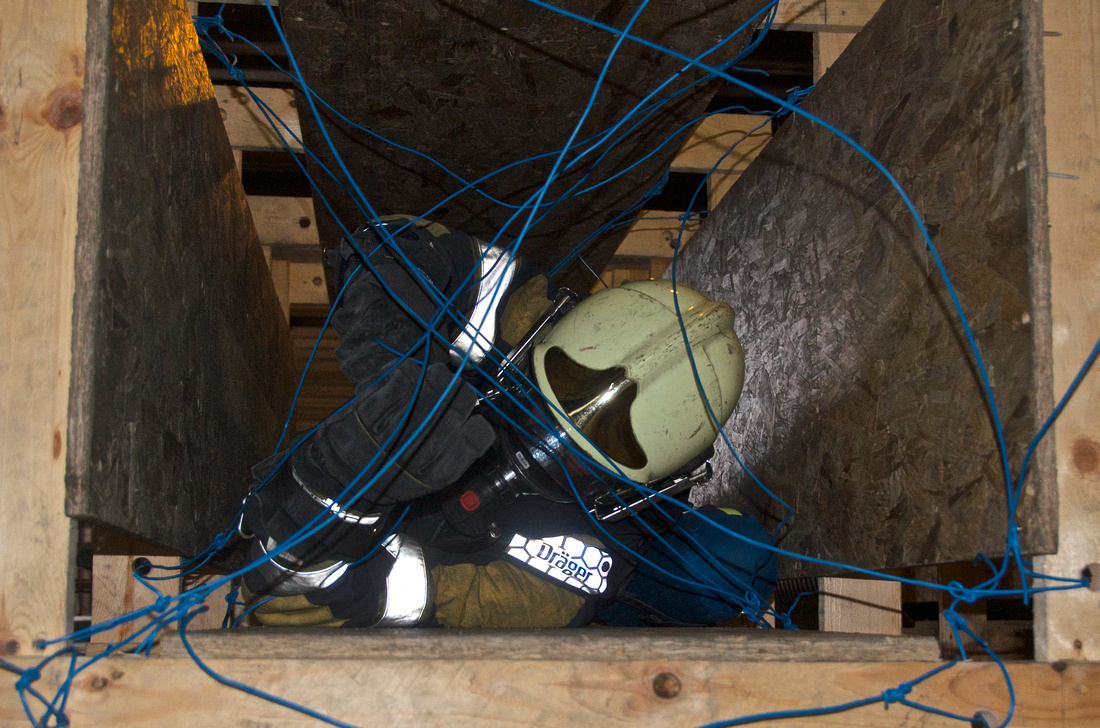 A firefighter working its way through a cable entanglement module.
A firefighter working its way through a cable entanglement module.
January 1st 2014, early morning. The Highland Park Fire Department, is working on a house on fire. The house is dark and filled with smoke. There is some heat. At some point two firefighters get disoriented and couldn’t find their way out. They called a madyday over the radios and the other firefighters on scene went into rescue mode. The lost team was found within minutes and escorted out of the house.[1]
May 1st 2007, fire departments are dispatched to a working house fire. There is a RIT (Rapid Intervention Team) assigned. After the intervention the RIT chief filed this report in into the “National Firefighter Near-Miss Report sytem”.[2]
“The RIT team arrived and staged at the A/D corner of the structure. We did a 360° of the building, set ladders checked conditions, tracked numbers and locations of crews working and stood ready. About 20 minutes into the response, crews lost water for a short time and were forced to retreat. After water supply was re-established the crews made a second aggressive attack. After about 10 minutes into the 2nd attack, the conditions rapidly deteriorated. After a quick consult (less than 20 seconds) with command the evacuation order was given and air horns sounded. Crews were attempting to retreat when there was a flash over. The RIT was activated due to lack of accountability of 2 crew members. The RIT made their way into the 1st floor, did a quick search, found 1 FF wandering in the first floor hallway dazed and confused. He was assisted to the front door and handed to waiting FF's from the RIT support. The crew then made their way to the second floor landing which was the other FF's last known location. Following the hose line, there were no other FF's located. The RIT was cut off by fire that was coming now from a first floor room across a ceiling and then across the stairway.
The fire was hit from a hose line manned by additional RIT members and allowed other RIT members to egress to the front door. At this point it was determined that all FF's were accounted for and out of the structure.”
In Europe, and Belgium more specific, some fire departments and training institutes are considering to start the formation of a RIT. With the training institutes wanting to provide the necessary training. But RIT has as many critics as believers. And both have their arguments that make sence. First of all a RIT has to be seen in the right perspective and secondly training has to be given in a proper way with a logic learning process. And this regarding each individual firefighter and the potential RIT member.
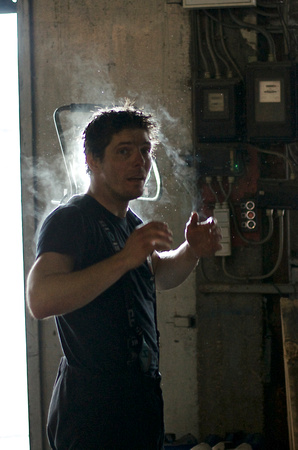 Auto combustion after a RIT fireground survival training?A firefighter cooling down after an intense SCBA Fireground survival training.
Auto combustion after a RIT fireground survival training?A firefighter cooling down after an intense SCBA Fireground survival training. The idea and concept of RIT, founded in the USA early ‘90ies, is in the first place a personal responsibility for each and every firefighter. With the introduction of RIT into the world of firefighting the number of Line-of-duty-deaths didn’t change change that much. In the last 36 years there were an average of 100 firefighter casualties a year in the USA. Recently, between 2003 to 2012, the 10-year average went below 100 and dropped to 88. And just the last years the numbers are going down significantly. Record lows were 2010 (72 casualties)[3], 2011 (81 casualties)[4] and 2012 (64 casualties)[5]. In 2013 the number went back up and will be more then 100. But let’s hope that the trend will stay that the numbers are dropping. Several hypotheses can explain the drop in LODD’s the last years. Since RIT started early in the ‘90ies and not much changed until 2009 one can wonder if it is possible that the founding and training of RIT teams in itself haven’t made the big difference, but rather a broader approach that results in more safety for each firefighter.
The idea and concept of RIT, founded in the USA early ‘90ies, is in the first place a personal responsibility for each and every firefighter. With the introduction of RIT into the world of firefighting the number of Line-of-duty-deaths didn’t change change that much. In the last 36 years there were an average of 100 firefighter casualties a year in the USA. Recently, between 2003 to 2012, the 10-year average went below 100 and dropped to 88. And just the last years the numbers are going down significantly. Record lows were 2010 (72 casualties)[3], 2011 (81 casualties)[4] and 2012 (64 casualties)[5]. In 2013 the number went back up and will be more then 100. But let’s hope that the trend will stay that the numbers are dropping. Several hypotheses can explain the drop in LODD’s the last years. Since RIT started early in the ‘90ies and not much changed until 2009 one can wonder if it is possible that the founding and training of RIT teams in itself haven’t made the big difference, but rather a broader approach that results in more safety for each firefighter.
The focus in the USA has been on tactics, tools and skills. In Europe on the other hand we have been researching and investigating fire behaviour and then teaching this to our firefighters. The general idea is that to beat your enemy, you must know and understand your enemy. On each side of the Atlantic fire departments followed the path that was believed to be the only one and the best one. But recently we are seeing steps on both sides to combine some of both approaches. I believe this more complete and broader approach, “the best of both worlds”, is the better one. With good learning opportunities for both continents. USA firefighters are quite often better trained in making vent-holes, forcible entry & exit, handling heavy low pressure hoses,…
We (Europe) on the other hand, became very experienced in reading smoke, understanding fire behaviour, optimizing cooling techniques with water,… But with recent building evolutions (Low Energy, Passive Houses,…) we (Europe) realize that sometimes making a ventilation hole can be necessary. Together with the fact that you might just want to take that ‘heavy’ low pressure 45mm hose with you to get better protection. But how the heck do you handle those? Well, our brothers on the other side of the ocean are so used to them that they play with them. They would water their flowers with our high pressure lines.
In the beginning RIT was only a Rapid Intervention Team that had to be on standby. Readily trained, in shape and with special tools to go rescue fire fighters in trouble. It became over time something that focused more on continuous overall fireground safety. Instead of only playing a reactive role, RIT takes up more and more a preventive role. They look for potential dangers, make observations from the outside, create extra exits when they are needed, …
Out of the scientific corner quite often the critique was made: you shouldn’t need RIT, you should stay out of trouble. And they will happily backup the statement that RIT simply doesn’t work. But I believe that this is not entirely true. There is a certain ‘It depends’ factor to it. Firebehavior is a science, that has become clear with all the research in Europe and the more recent research in the USA. But in our real world, the fireground, conditions aren’t standardized and not 100% predictable. In the meanwhile we read all these important and often well documented reports on failed RIT operations. But a problem is that we hardly keep records of the successful RIT-operations. And we definitely don’t keep track of all those incidents where the knowledge of some (simple) skill(s), learned in one of the RIT-modules, saved a firefighters life. Maybe it is RIT and the more thorough look at a fireground that is bringing the numbers down the last years. But not necessary through spectacular rescues, but rather through better training, preparation and more situational awareness. And this brings us to the very base of a good attitude towards RIT. If you consider starting up RIT training, you should know that this starts with training every single firefighter individually. It is the instructor’s responsibility to train every firefighter so that he or she can take personal responsibility for his or her personal safety.
The classic 7 modules are :
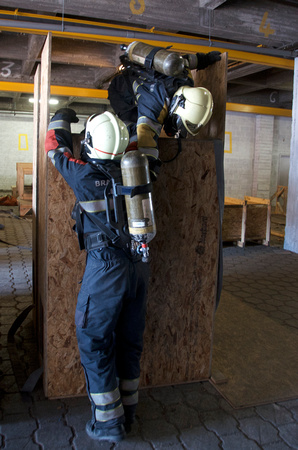 The high passage module.
The high passage module.
· Fireground survival and air management.
· Rescue techniques
· Forceable entry & exit
· Use of TIC
· SAR in large volume
· Self rescue & escape
· RIT commandement
Most of these subjects aren’t that well known in European fire departments. And when they are presented in the concept of a RIT course quite often there is some resent towards the idea. But imagine every single one of these modules would be presented as a single course. One that you could follow to become a better firefighter, who would be against it? Nobody I believe. So the next question is: “Where to start?” This is a very important one. With every training, every formation there is a starting point and you’ll advance step by step. The idea of doing the whole thing at once will give you weaker foundations and everything you build on it won’t hold up. As we all know, whatever we do, we better have solid skills, procedures, trainings,… so that they will stand the test when it is for real.
The base of good RIT is the very beginning of every fire fighters training. Every firefighter (on both sides of the ocean) should understand fire behavior to a quite advanced level. A firefighter has to be able to estimate what his enemy is currently doing and what he can expect it to do next. On top of that, he or she needs to know how he can win the battle from this enemy and which weapons are needed. And he or she needs to be able to handle the tools (low pressure, high pressure) to take the necessary measures. Would the situation be so that you can’t win, then know where to build up your defensive lines and how. Just here already you have knowledge and skills that have to go together smoothly. We want our firefighters to think about the conditions around them and what they should / can do to stay safe. But, to be able to do this the skills involved have to be automatized. You don’t want to think about the position of your nozzle when you decide it is time to gas cool. You should be able to have it in the correct position very quickly without thinking. Meaning: it has to be a reflex action In other words, the skills have to be moved from your conscious brain to your unconscious brain. There is only one way to reach this point: train, train and train. Can you imagine that you would have to think about how you are going to stop for that pedestrian? No! You instantly, through a reflex action, hit the brakes. And if you are better trained you can combine this with an evasive manoeuvre. A firefighter should be as well trained in life saving and protective measures when going into a fire as if he drives his car. And this is the same for your PPE and communication tools. A firefighter should work and play in full PPE (with SCBA) as easy as he drives his car. Again, working in full PPE, with SCBA, shouldn’t bother him. How many fire departments train their trainees to this level? And how many achieve the level of reflex actions when it comes to nozzle skills? There is a major challenge for every trainer to make these trainings fun, challenging, interesting, … Let’s be honest. When we do CFBT container trainings, what is the skill that quite often is lacking the most? Yep, hose and nozzle handling. If you are going to war and you are taking a gun, you should know how to fire it, reload it, take it apart and put it together again, … with your eyes closed. If your soldiers can’t do that, they will probably lose a battle now and then.Anything considering the SCBA should be part of the unconsciousness mind. It must become a reflex action. You should be able to rely on your reflexes in case anything happens to your SCBA.
For way too many firefighters this is still something that bothers them. It’s heavy, breathing isn’t that easy, vision is limited, talking is difficult, listening even more difficult, … In other words, before you know it a whole part of your conscious brain is occupied with handling a hose, manipulating the nozzle and being annoyed because you’re wearing a SCBA. On top of that there is the adrenaline rush because it looks that you are up for ‘a good one’.
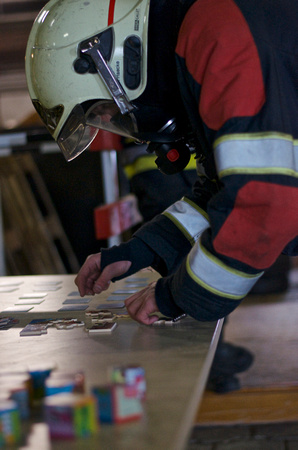 Puzzling firefighter with SCBA.A firefighter puzzling with his SCBA on but no bottle connected. The bottle lies a couple meters behind him. The exercise is part of a air management training.
Puzzling firefighter with SCBA.A firefighter puzzling with his SCBA on but no bottle connected. The bottle lies a couple meters behind him. The exercise is part of a air management training. So how many conscious brain capacity do you think is left over for situational awareness?
So how many conscious brain capacity do you think is left over for situational awareness?
And exactly this last little thing is what we want our fire fighters to be better at. We want them to be able to be aware of their situation while performing automatized skills. That’s a high expectation.
But even with all the best skills you learn in the world, and with all the knowledge we can have about fire behavior, fire has from time to time that unpredictable event. It would be ignorant not to prepare for the day when a fire fighter gets in trouble. And it doesn’t has to be one of those non-survivable events were he just shouldn’t be. If part one of your training went well chances are already maximized that your fire fighters won’t end up in one of those rapid fire progresses. But it might be one of those incidents that never made it to the statistics. An incident were the implementation of (a) RIT technique(s) and RIT procedures did a great job in getting your colleague out of his situation. Let’s say you have a structural fire and a firefighter goes through the floor. He ends up in the basement. There is smoke, the stairway isn’t there anymore, and the fire already travelled a little away from the basement. To make things worse your fire fighter broke a leg when he came down on the basement floor. How are you going to help that guy ? Some things have to fall in place here. And by naming these pieces of the puzzle it also becomes clear what the follow up training should be.
First of all: the fire fighter in trouble needs to be able to stay calm and send out a good understandable mayday message to his IC. So the first next thing to train to your firefighters is fireground survival. Included in this module is the mayday procedure and how to position yourself to be safe and optimize the chances to be found. Also in this module are tips and tricks to orient yourself and to help gather information so that the RIT can locate you asap.
Secondly the downed fire fighter needs to maximize the time left on air. He has to stay as calmly as possible, get as comfortable as possible and safely as possible. In order to use as little air as possible. The one and only thing a RIT team needs after you’ve transmitted a good mayday is time to get to you. And the only one who can buy time at this point is the firefighter that is trouble.
Fireground survival and air management isn’t about rushing around, jumping up and down,… It is about calmly finding your way through tight spaces while under SCBA, not forcing anything, looking for a possible exit or deciding to stay put and wait for the RIT. It is about sending out that lifesaving message: a good mayday. It is about learning what you can and can’t, so that you can fall back on that experience when it gets tight in real time.
It is a known fact that being able to stay calm and sending out a good mayday is a life saver for a fire fighter in trouble.
Every active firefighter should follow this training. And every IC should follow the training on how to respond to a mayday. If not, the existence of a RIT team is useless. With the skills from fireground survival and air management your fire fighters will try to buy the crucial time the RIT team needs to get to them. And the first thing this first team should bring to him is a package full of time. Meaning: a RIT pack with a bottle full of air, in other words: time.
So a next thing to train on is how to get to your colleague in trouble. Some individual techniques are trained in the module fireground survival. But to do this in team, well-coordinated, is a bit different. Also, one has to drag the RIT-pack with him and the team leader should carry the TIC. The TIC is used to follow up on the two guys searching and to locate the victim. And last but not least, they might have to force entry.
Once they reach the victim they should fall back on well trained skills:
· approach the victim
· identify
· check air and if possible vitals
· give immediate air supply if needed
· get ready to prepare the evac
It is very, very unlikely that the first RIT will be the team that will evacuate the victim. Once RIT is deployed for a full SAR the IC will need at least two or more RIT’s. The first team will start the search for the mayday while a second team needs to be on standby for the firefighters still working on the fire.[6] Out of research performed in Phoenix and Seattle it was learned that the total number of RIT-members needed to rescue one firefighter is 11 RIT-members (Seattle) or 12 RIT-members (Phoenix)[7]. Once the first team is starting their search, a second team should be on standby. This second team will have to go in and start to prepare the evacuation. This means prepping the victim. For this the use of the SCBA as a harness is crucial. And it can also mean that they will have to force exit.
So at this point you have four modules coming together:
· (1) fireground survival and air management
· (2) forcible entry and exit
· (3) rescue techniques
· (4) Use of TIC’s
Every single module on itself is a surplus for every firefighter. Every firefighter can use good SCBA skills (1) on a fire. It can be very handy to be able to quickly open up a door, or to create an alternative entry on a fireground (2). A TIC is a tool that is available to more and more firefighters. So let’s get trained in using it (4). And any rescue techniques that you learn for a firefighter will come in handy when you have to rescue a civilian (3).
This means that these four modules can be seen as an extended fire fighter training after the basic training. And skills should be trained regularly. RIT shouldn’t be the reason to train on these skills, just the fact that you want to be a better fire fighter should do it.
[1] From NBC5, Dallas Fort Worth, “Close call for Highland Park firefighters” by Greg Janda, Jan 1 2014.
[2] http://www.firefighternearmiss.com report number: 07-0000890
[3] From NFPA, 2010 Firefighter Fatalities in the United States. Author(s): Rita Fahy, Paul LeBlanc, Joseph Molis Published on July 1, 2011
[4] From 2011 LODD stats (The Secret List), January 3, 2012 Hey (USA).
[5] From NFPA, Firefighter Fatalities in the United States, 2012. Author(s): Rita Fahy, Paul LeBlanc, Joseph Molis Published on July 1, 2013
[6] The development and use of rapid intervention teams for the Chelmsford, MA. Fire department. By John E. Parow, Fire Chief Chelmsford Fire Department Chelmsford, MA
[7] From Too Little, Too Late by Gary Morris Thu, 2005-09-01
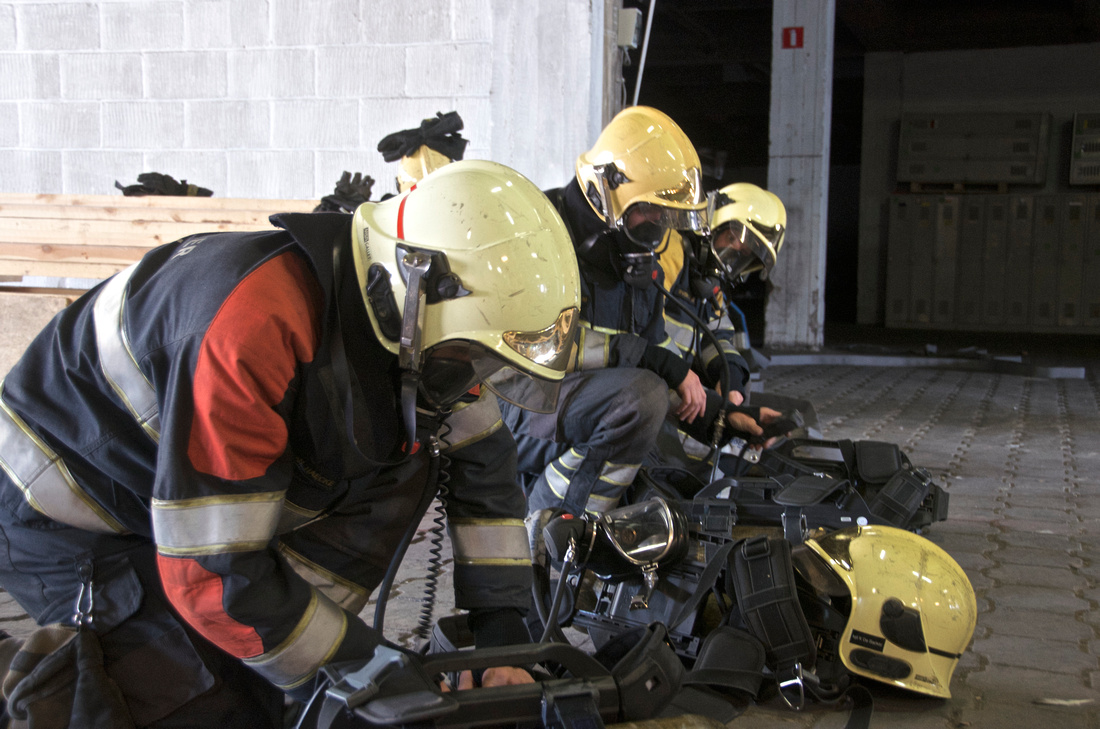 Firefighters taking in some air during an air management exercise.
Firefighters taking in some air during an air management exercise.